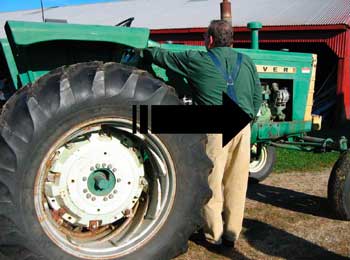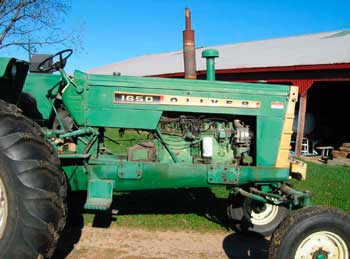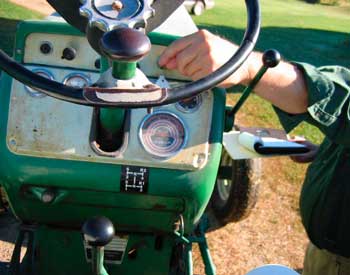Farmer Died When Run Over by Rear Wheel When He Started the Tractor While Standing On the Ground
Michigan Case Report: 04MI108
Summary
On June 29, 2004, a 78-year-old male farmer was severely injured when he was run over by the rear wheel of his 1960s vintage model 1650 Oliver tractor. The deceased had hooked up a 150-gallon pull-type boom sprayer so he could eradicate weeds near his 60-acre soybean field. After dismounting from the tractor and mixing the solution in the sprayer, he attempted to start the tractor while standing on the ground. Unbeknownst to him, the tractor was in forward gear and when he started it he was unable to move out of the way of the rear tire and the tire ran over him. The tractor continued its forward movement and entered the second bay of a lean-to barn and was stopped by the side of the barn where the engine eventually stalled out. Figure 1 shows the victim’s probable location on the ground in front of the tire while he started the tractor and the direction of the tractor’s movement. His wife found him lying on the ground approximately 45 minutes later. Upon finding him, the wife returned to the house and called 9-1-1. When she returned to him, he was conscious and spoke to her, stating that he had been run over by the rear tire of the tractor. Emergency Response arrived and stabilized him at the scene He was taken to the local hospital. He died approximately three weeks later as a result of the injuries sustained at the time of the incident.

|
|
Figure 1. MIFACE researcher standing in victim’s probable location while starting tractor and tractor movement.
|
Recommendations:
- Tractors should only be started when the operator is on the tractor platform sitting in the operator’s seat.
- A farm safety plan should be established for the agricultural operation that includes work rules such as starting the tractor from a seated position on the operator’s platform.
- Agricultural equipment operators should recognize the potential human factor limitations associated with aging.
Introduction
On June 29, 2004, a 78-year-old male farmer was run over by the by the rear tire of his tractor. MIFACE investigators were informed of this incident by a newspaper clipping. On September 27, 2004, MIFACE investigators visited the farm, talked with the wife and son of the deceased, viewed the accident scene and were permitted to take pictures of the tractor involved in the incident. The individual seen in the pictures is a MIFACE researcher. During the writing of this report, the police department report and the death certificate were obtained.
The deceased had worked at farming all of his life although he did have a main occupation other than farming from which he had retired. He had lived at this location for about 30 years. The deceased had a total of 280 acres of which 150 were tillable that his neighbor leased to plant and harvest corn. The victim had planted 60 acres of soybeans. The victim was very familiar with the work area and the work being performed at the time of the incident. The incident occurred in the victim’s barnyard while he was preparing the sprayer. The victim did not have a written health and safety plan for his farm.
The wife indicated that on the day of the incident that the victim appeared “to be in a hurry” all day and had hurried through most of the tasks that he had performed that day. His wife also indicated that the victim had had a left knee replacement previously. He also had difficult using his right hand so he would use his left hand for many tasks including steering the tractor.
Back to Top
Investigation
The deceased had purchased the wide-front, gasoline-powered 1650 Oliver tractor new in the 1960s. It is unknown if the victim had the operator’s manual available. The clutch and brake pedals on the tractor were smooth on the pedal surface. The six-ply, chloride-filled rear tires added weight for traction. The tractor had a neutral gear, but did not have a neutral-start safety feature. Figure 2 shows an overview of the tractor. The gearshift was 23 inches long. It was located on the floor between the tractor seat and the dash under the steering wheel, approximately six inches from the dash at its base on the floor. The edge of the seat to the dash was approximately 13 inches. The tractor key was approximately 67 inches off of the ground on the operator’s right when seated on the tractor. The distance from the key to the center of the rear tire was 36 inches. The victim attached a homemade step to each side of the tractor as an assist in mounting and dismounting the tractor.

|
|
Figure 2. Tractor involved in incident from the operator’s right side.
|
The victim attached a 150-gallon pull-type boom sprayer to the rear of the tractor. The sprayer was hooked to the PTO to activate the mixing unit. The victim was preparing the sprayer so he could treat weeds growing around his soybean field.
The victim’s wife stated there had been a problem with the water pump near the barn. She observed the victim driving the tractor/sprayer up to the house to use the water pump near the house to fill the sprayer with water. She also observed the victim driving back to the barnyard area. The victim had purchased a new wand to perform spot spraying from the sprayer mixer. The family suggested that he might have driven the tractor to this location to test the new wand for leaks.
As the event was unwitnessed, the circumstances leading to the victim being run over are postulated based on the interviews with the victim’s wife and son.
After filling the sprayer with water, the victim drove the tractor back to the barnyard to add the chemicals. Chemicals were usually added to the sprayer in a different location on the incident site. Prior to adding chemicals to the sprayer, he would have activated the PTO to activate the pump’s mixer. He had moved the throttle position to increase engine speed above idle speed to allow agitation of the materials within the sprayer.
His son stated that his father, prior to dismounting the tractor, would place the gearshift in neutral and turn the tractor key to the “off” position. He would not normally depress and lock the tractor brakes. The victim usually dismounted the tractor from the operator’s left side because of his knee replacement. It is hypothesized that while attempting to dismount from the tractor, one of the victim’s legs struck the gearshift and placed it into first gear.
Unbeknownst to him the tractor was in gear. Standing on the ground in front of the operator’s side right rear tire, he reached up to turn the key to start the tractor’s engine. Because the tractor was in gear, it began to move forward. He was unable to get out of the way of the rear tire. (See Figure 3). The tractor ran over him, continued on into a lean-to type barn, entered the second bay in the barn and was stopped by the side of the barn where the engine eventually stalled out.
When he did not return home for supper, his wife looked for him and found him lying on the ground, his head facing east and his feet to the west. She went back to the house and called 911. When she returned to him he was conscious and spoke to her, stating that he had been run over by the rear tire of the tractor. The victim was transported to a local hospital. He died three weeks later as a result of the injuries sustained at the time of the incident.

|
|
Figure 3. Location of tractor starter key, gearshift and steering wheel.
|
Back to Top
Cause of Death
The cause of death as stated on the death certificate was multiple blunt force trauma. An autopsy and toxicological tests were not performed.
Recommendations/Discussion
Recommendation #1: Tractors should only be started when the operator is on the tractor platform sitting in the operator’s seat.
The operator’s seat of farm tractors and other machines provides a workstation from which the operator can maintain proper control of the machine. When a tractor engine is started in gear, it may move suddenly and run over anything in its path. Starting the tractor while it is in gear is an unsafe practice. Proper control is necessary not only during operation of a tractor or machine, but also whenever an engine is started. While seated in the operator’s seat, an operator should check the engine throttle position, disengage the clutch and shift the transmission into neutral or park before the engine is started. Setting the brakes will prevent the tractor from rolling before the operator engages the transmission. Before starting a tractor engine, the operator should also ensure the power take off is disengaged. Performing these steps will reduce the likelihood of a tractor or machine accidentally moving forward or backward after the engine starts. In addition, if a tractor or machine does unexpectedly begin to move after starting, an operator seated in the seat will not be in danger of being run over and will be in position to maintain safe operating control.
Many modern tractor systems are equipped with additional safety interlock systems. Tractors equipped with neutral-start safety switches prevent the starter from cranking the engine if the transmission or clutch is engaged. When using an older model tractor without these safety interlock systems, one must be particularly careful to follow safe tractor starting procedures.
Recommendation #2: A farm safety plan should be established for the agricultural operation that includes work rules, such as starting a tractor from a seated position on the operator’s platform.
There are no legal requirements in Michigan for a written safety plan in agricultural industries. We recommend a written safety plan. This plan will identify the safety and health hazards for the farm, so hazard controls can be developed. A safety plan that is communicated to all who work on the farm will help raise awareness of safety issues, promote safe work practices, and have additional benefits of increasing work efficiency, and minimizing costs. A written safety plan may reduce worker compensation premiums. A safety plan should include work rules, such as safe tractor operation.
Pacific Northwest Agricultural Safety and Health Center (PNASH) developed a sample written farm safety and health program. This sample program can be found and downloaded from the Internet: http://www.cals.uidaho.edu/agsafety/frmsaf01.pdfpdf iconexternal icon. (Link updated 8/5/2009) The Texas Cooperative Extension Service has developed a sample farm safety inspection checklist encompassing barns and buildings, animal facilities, grain storage and handling facilities, farm shops, chemical storage and handling facilities, farm machinery, fuel storage and handling facilities, and the general farmstead. The checklist may be found on the Internet at http://agsafety.tamu.edu/files/2011/06/CONDUCTING-FARM-SAFETY-INSPECTIONS1.pdfpdf iconexternal icon (Link updated 3/25/2013)
Recommendation #3: Agricultural equipment operators should recognize the potential human factor limitations associated with aging.
Farmers often continue to work on their farms well past “retirement” age. Cognitive and/or functional impairments are often associated with advanced age. Cognitive impairments can affect the following areas: attention, judgment and problem solving, increased reaction time, lapses of consciousness or control, and memory lapses. Functional impairments, including sensory impairments, can affect vision, peripheral sensation of the extremities, strength, flexibility and coordination. The victim had physical problems with his knee and his hand that may have limited his ability to mount/dismount the tractor, which may have played a role as to why he started the tractor from the ground instead of in the operator’s seat. Older workers should recognize these limitations and seek help from relatives and/or friends to accomplish a work activity when required.
Reference
- Farm and Ranch Safety Management, 4th Edition, Copyright 1994, Deere & Company, Moline, Illinois.
- Pacific Northwest Agricultural Safety and Health Center (PNASH). Developing a Safety and Health Program to Reduce Injuries and Accident Losses. Farm Safety Series PNW 512. December 1998. Internet Resource: http://www.cals.uidaho.edu/agsafety/frmsaf01.pdfpdf iconexternal icon (Link updated 08/5/2009)
- Texas Cooperative Extension. Conducting Farm Safety Inspections. Internet Resource:
http://agsafety.tamu.edu/files/2011/06/CONDUCTING-FARM-SAFETY-INSPECTIONS1.pdfpdf iconexternal icon (Link updated 3/25/2013)
Michigan FACE Program
MIFACE (Michigan Fatality Assessment and Control Evaluation), Michigan State University (MSU) Occupational & Environmental Medicine, 117 West Fee Hall, East Lansing, Michigan 48824-1315. This information is for educational purposes only. This MIFACE report becomes public property upon publication and may be printed verbatim with credit to MSU. Reprinting cannot be used to endorse or advertise a commercial product or company. All rights reserved. MSU is an affirmative-action, equal opportunity employer. 3/18/05
MIFACE Investigation Report # 04MI108 Evaluation (see page 6 of report)
To contact Michigan State FACE program personnel regarding State-based FACE reports, please use information listed on the Contact Sheet on the NIOSH FACE web site Please contact In-house FACE program personnel regarding In-house FACE reports and to gain assistance when State-FACE program personnel cannot be reached.
